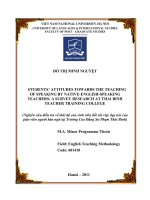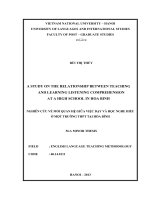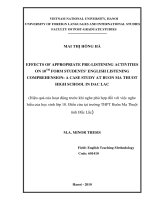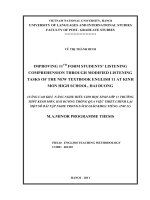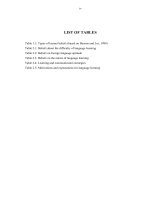Challenges in teaching new textbook “english 6” at a secondary school in rural area in hanoi a survey study
Bạn đang xem bản rút gọn của tài liệu. Xem và tải ngay bản đầy đủ của tài liệu tại đây (1.34 MB, 64 trang )
VIETNAM NATIONAL UNIVERSITY, HANOI
UNIVERSITY OF LANGUAGE AND INTERNATIONAL STUDIES
FACULTY OF POST-GRADUATE STUDIES
*********************
TRẦN THỊ HẢI YẾN
CHALLENGES IN TEACHING NEW TEXTBOOK “ENGLISH 6” AT A
SECONDARY SCHOOL IN RURAL AREA IN HANOI: A SURVEY STUDY
(Những thách thức trong việc dạy sách giáo khoa Tiếng Anh 6 mới tại một
trường THCS ngoại ô Hà Nội- một nghiên cứu khảo sát)
M.A MINOR PROGRAMME THESIS
Field: English Teaching Methodology
Code: 8140231,01
HANOI – 2019
VIETNAM NATIONAL UNIVERSITY, HANOI
UNIVERSITY OF LANGUAGE AND INTERNATIONAL STUDIES
FACULTY OF POST-GRADUATE STUDIES
*********************
TRẦN THỊ HẢI YẾN
CHALLENGES IN TEACHING NEW TEXTBOOK “ENGLISH 6” AT A
SECONDARY SCHOOL IN RURAL AREA IN HANOI: A SURVEY STUDY
(Những thách thức trong việc dạy sách giáo khoa Tiếng Anh 6 mới tại một
trường THCS ngoại ô Hà Nội- một nghiên cứu khảo sát)
M.A MINOR PROGRAMME THESIS
Field: English Teaching Methodology
Code: 8140231,01
Supervisor: Dr. Tran Thi Thu Hien
HANOI – 2019
DECLARATION
I, the undersigned, hereby certify my authority of the study project report
entitled “ Challenges faced by English teachers in teaching new textbook “English
6” at a secondary school in rural area in Hanoi: a survey study” is submitted in
partial fulfillment of the requirements for the degree of Master in English
Linguistics. This is the result of my own work. Except where the reference is
indicated, no other person‟s work has been used without due acknowledgement in
the text of the thesis.
Approved by
Signature
Tran Thi Hai Yen
i
ACKNOWLEDGEMENTS
First of all, I would like to express my sincere thanks to my thesis supervisor,
Dr. Tran Thi Thu Hien for her appreciated advice, her gradual assistance and her
useful correction, without which I would find it difficult to fulfill my thesis.
I am grateful to my colleges at secondary school, who are enthusiastic to
help me in my data collection process as well as a lot of students who are willing to
become participants in my research and support me with valuable responses.
Finally, I wish to appreciate my close friend, my classmates, my family who
were supportive and helpful to give me necessary advices and stimulation during
my thesis completion.
ii
ABSTRACT
This research emphasizes on examining the challenges encountered by
English teachers in teaching the new English textbook for 6th grade learners at a
secondary school in rural area of Hanoi, and comes up with essential
recommendations for the issues. For serving as the data sources of this study, three
English teachers and 146 grade-6 students at the school have been surveyed and
interviewed. By triangulating data collected from 3 instruments namely interviews,
questionnaires and classroom observations, the challenges faced up with by English
teachers were found out, including the learners‟ poor studying habits, learners‟ low
level of English proficiency, time constraint, inadequacy of school facilities,
shortcoming of supplementary teaching materials, immovable classroom setting and
large class size . To get better teaching practice with the new textbook “English 6”,
the recommendations were proposed as an inevitable part of the study. In other
words, variety of suggestions for better teaching and using of the new textbook
“English 6” were proposed with regard to the authoritative, the teachers, the
learners, and the textbook designers.
iii
TABLE OF CONTENTS
DECLARATION ....................................................................................................... i
ACKNOWLEDGEMENTS ..................................................................................... ii
ABSTRACT ............................................................................................................. iii
TABLE OF CONTENTS ........................................................................................ iv
LIST OF ABBREVIATION ................................................................................... vi
LIST OF TABLES AND FIGURES ..................................................................... vii
PART A: INTRODUCTION ....................................................................................1
PART B: DEVELOPMENT.....................................................................................4
CHAPTER 1. LITERATURE REVIEW ................................................................4
1.1. Textbooks .............................................................................................................4
1.1.1. Definitions of textbooks ....................................................................................4
1.1.2. Roles of textbooks .............................................................................................4
1.1.3. Advantages and disadvantages of textbooks .....................................................5
1.2. Communicative language teaching (CLT) ...........................................................6
1.2.1. Definitions of CLT ............................................................................................6
1.2.2. Principles of CLT ..............................................................................................7
1.2.3. Peculiarities of communicative methodology ...................................................8
1.2.4. CLT in Vietnamese teaching context ..............................................................10
1.3. Review of previous related studies ....................................................................12
1.3.1. Previous oversea studies .................................................................................12
1.3.2. Previous studies in Vietnam ............................................................................13
1.4.Chapter summary ................................................................................................14
CHAPTER 2: METHODOLOGY .........................................................................15
2.1. Setting of the study.............................................................................................15
2.2.1. Students ...........................................................................................................16
2.2.2. Teachers ..........................................................................................................17
2.3.Research methods................................................................................................17
iv
2.4. Data collection instruments and procedures ......................................................18
2.4.1. Interviews ........................................................................................................18
2.4.2. Questionnaires .................................................................................................19
2.4.3. Classroom observation ....................................................................................20
2.5 Data analysis .......................................................................................................20
2.6. Chapter summary ...............................................................................................20
CHAPTER 3: FINDINGS AND DISCUSSION ...................................................21
3.1. Challenges faced by teachers in teaching new textbook “English 6” at a
secondary school in rural area of Hanoi ....................................................................21
3.1.1.Challenges related to students ..........................................................................21
3.1.2. Challenges related to teaching skills and language components ....................22
3.1.4.Other challenges ...............................................................................................32
3.1.5. Challenges in teaching the new textbook “English 6” compared with teaching
the former textbook “English 6” .............................................................................. 34
3.2. Implications ........................................................................................................34
3.2.1. For school authorities ......................................................................................35
3.2.2.For teachers ......................................................................................................35
3.2.3.For students ......................................................................................................38
3.2.4.For textbook designers .....................................................................................38
3.3.Chapter summary ................................................................................................38
PART C: CONCLUSION.......................................................................................39
REFERENCES ........................................................................................................41
APPENDICE ............................................................................................................. I
APPENDIX 1 ............................................................................................................. I
APPENDIX 2 .......................................................................................................... VI
APPENDIX 3 ......................................................................................................... VII
APPENDIX 4 .......................................................................................................... XI
v
LIST OF ABBREVIATION
CLT: Communicative Language Teaching
MOET: Ministry of Education and Training
CEFR: Common European Framework of Reference
NFL: National Foreign Language
vi
LIST OF TABLES AND FIGURES
Table 2.1. The lessons‟ focus of the new textbook “English 6” ...............................16
Table 2.2. The teachers‟ background information ....................................................17
Figure 3.1. Students‟ studying habits in English .....................................................21
Table 3.1. Lessons ranked according to their levels of difficulty in teaching ..........22
Table 3.2. Skills ranked according to their degree of difficulty in teaching .............23
Figure 3.2.Students‟ challenges in studying listening skills .....................................24
Firgure 3.3. Students‟ challenges in studying speaking skill ....................................25
Firgure 3.4. Students‟ challenges in studying reading skill ......................................26
Figure 3.5. Students‟ challenges in studying writing skill ........................................27
Table 3.3. Language components ranked according to their level of difficulty in
teaching .....................................................................................................................28
vii
PART A: INTRODUCTION
1. Rationale
With the purpose of enhancing English communicative competence
effectively among Vietnamese youth, the National Foreign Language (NFL) project
has been issued since the year of 2008. To satisfy the objectives set in the NFL
project, the need of reformulating English teaching and learning serves as a
requirement. As a result, since 2012, the series of English textbooks from grade 3 to
grade 12 has been published and piloted in a number of Vietnamese institutions.
The new textbook series has been designed after the communicative approach with
the hope of developing communicative competence of the learners. This is
considered a remarkable change from the former textbook series which also worked
with 4 skills but let teachers tend to focus more on grammar. Since the series of the
new textbooks has been piloted in several schools in Vietnam, most of teachers who
teach the books in this series held positive attitude on the books‟ design, content and
the book approach. In addition, English teachers are encouraged to take part in
training courses in new teaching methodology to adapt themselves well with the
expected teaching and learning approach of the new textbooks.
Beside the positive features of the new textbooks recognized by most of
English teachers, the new textbook requires the English teachers a lot of effort to
cover all its aspects with expected method within the time bound. Being a teacher
who has used the new textbook “English 6” in teaching for 2 years, the researcher
realized that English teachers faced a number of challenges in teaching the new
textbook with the expected teaching method. For that reason, the study is carried out
with the purpose of revealing the challenges that English teachers face up with in
teaching the new English textbooks “English 6” at a secondary school in rural area
of Hanoi, and come up with possible suggestions to solve the stated difficulties.
2. Objectives of the study
The interrelated objectives of the study are indentifying the challenges that
teachers have faced up with in teaching new textbook “ English 6” issued by
1
Education Publishing House co-operating with Pearson Education in the rural
teaching context in Hanoi, and finding out the solutions to overcome the challenges
stated in the research.
3. Research questions
In order to identify the teaching challenges as well as work out the
implications for the challenges found, it is necessary to solve the answers for the
following questions. The first question is the main focus of the study.
1. What are the challenges faced by English teachers in teaching the new
textbook “ English 6”?
2. What are possible suggestions to overcome the challenges found?
4. Methods of the study
The main purpose of this study is to explore challenges teachers encountered
in
using the new “English 6” textbook, and propose the recommendations to
overcome the challenges. To achieve this purpose, a mixed research method with
greater emphasis on qualitative and quantitative approach was employed.
5. Scope of the study
Due to time constraint and the shortcoming of the minor thesis, the
researcher only concentrates on the challenges that teachers coped up with in
teaching the new textbook named “English 6”. Accordingly, the focus on the other
subject matters including the other new textbooks in the new series with other types
of teachers and learners is out of the scope of the study.
6. Significance of the study
Theoretically, due to the fact that the new textbook is designed after the
communicative approach, this study involves in discovering the challenges in
conducting communicative teaching methodology in Vietnamese teaching context.
In particular, the finding of this research is supposed to make a significant
contribution to the development of the pedagogical practice of teaching and
studying with the new textbooks in the new series in general, and with the new
textbook “ English 6” in specific.
2
In addition, the study can also be a practical source of reference for teachers
who are teaching English in the same context.
7. Design of the thesis
The study consists of 3 parts: Introduction, Development and Conclusion.
Part A. Introduction, presents the general introduction of the study,
consisting of rationale, objetives of the study, research questions, methods, scope,
significance and design of the study.
Part B. Development, consist of three chapters: Literature review,
Methodology, Findings and Discussion.
Chapter I. Literature review, presents the most important works related to
the textbooks and communicative teaching methodology, including: textbook
definitions, roles of textbook, merits and demerits of the textbooks, communicative
language teaching definitions, communicative teaching principles, perculiarities of
communicative languaguage teaching, communicative language teaching in
Vietnamese pedagogical context.
Chapter II. Methodology, provides information about research methods,
setting, participants, data collection instruments, data collection procedures, data
analysis procedure.
Chapter III. Findings and Discussion, analyses and discusses the data
collected from teacher interviews, survey questionnaires, classroom observations.
At the same time, the implications are proposed as an inevitable part of the study.
Part C. Conclusion , presents the major findings, limitations of the study
and ends up with ideas for further studies.
References and indexes serve as the last components of the thesis.
3
PART B: DEVELOPMENT
CHAPTER 1. LITERATURE REVIEW
1.1. Textbooks
1.1.1. Definitions of textbooks
Textbooks play an essential role in teaching and learning language. There
have been a number of definitions of textbooks. Firstly, according to Sheldon
(1987: 1-10), textbooks were mentioned as a published written version for
improving both learners‟ linguistic and communicative abilities. Besides, Harris and
Hodges (1995: 124) stated that textbooks were paperbacks used in colleges for
aiding students with their studying in a specific branch. After that, it was claimed by
Byrd (2001: 415-427) that textbooks were considered as the main source for
teaching and learning procedure, which served as the centralized desicion –making
agents prescribed by Ministry of Education. Further, it was also defined clearly in
Longman dictionary that textbooks were books containing series of lessons
frequently used for the specific subject.
Above all, it can be concluded from the definitions mentioned above that
textbooks serve as the main document that assisted the studying of the learners in a
particular academic domain. In Vietnam, textbooks are
regarded as the major
coursebooks that teachers and students followed in their teaching and studying at
school. They are promulgated by the Ministry of Education and Training (MOET)
and irreplacable without the permission of MOET.
1.1.2. Roles of textbooks
A number of researchers have claimed that there was a great amount of
necessity that textbooks brought about. First, according to Hutchinson and Torres
(1994: 315-328), text books could serve as supporting teaching tools for teachers
and as the instruments of modification and alteration. Also, learners need text books
to guide them towards the hard process of learning. Besides, McGrath (2002: 8-10)
mentioned that textbooks provide teachers and learners with a structure of teaching
and learning, methodological support, opportunities for revision and preparation.
4
Gelfman, et al. (2004) provided a basic outline for the intermediary role of
the textbooks, including: (i) instructing learners in forming the new knowledge, (ii)
making a balance between the detail and precision of the information, (iii) including
a systematic knowledge,(iv) suggesting new ideas, (v)supporting learners with
dimensional information.
To sum up, the textbooks serve as important source for both teachers and
learners in their teaching and studying process. Textbooks provide teachers with
specialized help, including preparation, modification and review activities. For
learners, textbooks accompany them with instruction in forming and evaluating
knowledge systematically. This study also affirms that textbook plays a crucial role
in processing the studying of learners as well as backing up the teaching procedure
effectively.
1.1.3. Advantages and disadvantages of textbooks
The value of using textbooks is apparently undeniable. The subsequent
explanations were obviously made for the importance of using textbooks in
teaching. Firstly, according to Ur (1996: 184), the advantages of textbooks were
mentioned as followed: (i) textbooks role as a visible map for teaching and learning
process, which ensured that the teachers and learners were going on right track; (ii)
textbooks serve as syllabi in which the language content was scientifically
organized and calculated, (iii) textbooks encompass ready-made texts and tasks in
appropriate levels for saving teaching time and effort; (iv) textbooks are at
affordable price for users; (v) teachers could make use of textbooks as an insurance
of knowledge on every occasion that they were undecided or whensover they were
inexperienced teachers; (vi) for learners, textbooks could be exploited as an
elemntary source for their self-studying in which they were provided with available
drills for reevaluation and constructing original ideas.
According to Richard (2001: 2), the disadvantages of textbooks were
included as followed: (i) textbooks comprise inauthentic language; (ii) the subject
matters encompassed in the textbooks could be biased for eluding debated issues;
5
(iii)
textbooks are incompatible with learners‟ needs; (iv) the exploitation of
textbooks could contribute to teachers‟ tendency of de-skilling themselves; (v) the
cost of textbooks could be expensive for several learners.
All in one, the benefits of using textbooks were various, including the
capacity of giving lessons to learners methodically, and offering essential assistance
for novice teachers. Besides , there are drawbacks that could be seen in using
textbook for teaching and studying, which include the mismatch of the textbooks
and learners‟ needs, the matter of controversial topics, inauthentic inputs, teachers‟
skills or the textbooks‟cost.
1.2. Communicative language teaching (CLT)
1.2.1. Definitions of CLT
There have been a number of theorists who have claimed the definitions of
CLT. According to Richard (1974: 2), CLT could be understood as a system of
principles about the goals of language teaching, the method learners learned a
language , the kinds of classroom activities that best facilitate learning, and the roles
of teachers and learners in the classroom. CLT begins a movement away from
conventional lessons formats where the focus is on fluency of variety of grammar
items which are recyled through controlled activities toward the employment of cooperative work and project work. Teachers are assumed to be the facilitator and
monitor of the students‟ learning process. Learners now have to promote their
activeness to take part in cooperative rather than individualistic approach to
learning.
Further, Nunan (1989: 194) emphasised that CLT embraces a series of
meaningful expressions for meaning, which also emcompasses activities for
strengthening oral communication. In term of objective, CLT developes not only
learners‟
linguistic
but
also
communicative
competence.
Teachers
take
responsibilities as the facilitators of the learning process; the learners roles as
negotiators, and integrators. Resources which are supplied in communicative
teaching are authentic and task-based.
6
Brown (2007: 44) defined CLT as an approach to methodology of language
teaching that focuses on authenticity, communication, student-centered studying,
task based activities, and communicative transaction for the real world with
meaningful functions.
In summary, CLT focuses on meaningful tasks that create the
communication opportunities through collaborative works. Further, according to
CLT approach, teacher‟s role and students‟ role have been transformed significantly
compared with the traditional teaching method. In particular, teachers and students
interact considerately in teaching and learning process; learners actively participate
in their studying activities; teachers are facilitators, supporters, inspirers in their
students‟ learning process.
1.2.2. Principles of CLT
There were a numbers of theorists who have made an effort to work out the
principles of CLT . For circumstances, Nunan (1991: 279-295) stated 5 principles of
CLT consisting of: (i) the weight of interactive activities, (ii) the significance of
authentic materials, (iii) the individual learning progress, (iv) the personal
experience reflection, (v) the practice of the target language in the social context.
Xiaoqing (1996: 14-24) included 5 principles of CLT, which were: (i)
produce interactive activities and present the information gap, (ii) provide brief
explanation and diverse drills, (iii) focus on both accurateness and smoothness, (iv)
stimulate the use of English and use of mother tongue when necessary, (v) promote
integration of all four skills with varying stresses on specific skills of different
stages.
Doughty and Long (2003:89) defined a series of principles which can be
used as a guideline for applying CLT, which included: (i): using tasks as
systematics principles, (ii) learning by doing, (iii) input needs to be diverse, (iv)
input needs to be significant, apprehensible and particular; (v) enforcing
coordinated learning; (vi) emphasizing on form; (vii) producing error corrective
feedback; (viii) accepting affective factors of learning.
7
In conclusion, CLT encompasses of a variety of principles which in general
focus on the collaborative learning, the meaningfulness of the inputs, the integration
of skills, the significance of target language environment, and personal studying
progress.
1.2.3. Peculiarities of communicative methodology
The practice of four language skills including: listening, speaking, reading
and writing plays an important role in developing learners‟ communicative
proficiency. With respect to that, it was mentioned by Richards and Rodgers (1991:
66) that CLT aims at : (a) making communicative competene the target of language
teaching ; (b) developing procedures for teaching of four language skills including
productive skills ( speaking and writing) as well as receptive skills ( listening and
reading) that acknowledge the interdependence of language and communication.
In addition, according to Semistraitis (2003: 7-10), the peculiarities of the
Communicative Approach were characterized by promotion of learners‟
communicative ability through a wide range of language skills and communicative
assessment system.
1.2.2.1. Developing reading skills
Reading is a cognitive form of perception through printed word. It is an
individual work. First, in every circumstance, teachers have to explicit the reason
for reading for learners, and learners need a sense of interest in the reading text.
Second, reading must be purposeful when the students use their cognitive ability to
analyze the reading questions, solve the question logically base on what they read.
Finally, because reading enriches the vocabulary, teachers must associate what is
read with the students‟ personal experience and personal emotional impressions. It
can be a topic for discussions in the class.
1.2.3.2. Developing listening skills
Oral forms of language communication are listening comprehension and
conversation. That was the reason why listening and speaking sort should be taught
interchangeably, and one skill should be the base for developing the others. For
8
teaching effective listening, it is teachers‟ determination to direct students to
comprehend the gist of particular listening texts despite its kinds of text or speed of
recordings.
1.2.3.3. Developing speaking skills
It is vital that teachers make the freedom of the frame of communicative
abilities clear to the students. In another words, it is necessary to stimulate students
to act together to the highest degree in class regardless to their failure or success.
For obtaining this goal, first and foremost, the interactive activities should be
reinforced. The basic spoken communication including imitating, retelling should
come first, and go along with more challenging tasks as soon as students grasp
significant amount of lexicon and sentence structures. Specifically, the grammatical
rules, by any means, should not impede comprehension as well as transmittance of
the conversation. In another word, forms are used in their grammatical correctness;
nevertheless, it is advisable to prioritize the smoothness of the speech.
1.2.3.4. Developing writing skills
In developing writing skill for learners, teachers are suggested to take into
account the significance of writing. For circumstance, firstly, writing is an evident
that represents the learners‟ personal advancement, though it might be not always
reflects the existent condition. Moreover, writing develops learners‟ logical thinking
which its concentration is on the major viewpoints. Last but not least, writing is
effective to learners whose dominant studying manner was writing.
1.2.3.5. Testing
Testing is an integrated part of the learning process. Henceforth, testing must
be completed in terms of communication. Testing is necessary to cover full aspects
of language: listening comprehension, reading comprehension, writing abilities,
speaking abilities.
Above all, the perculiarities of CLT supposed that language skills must be
promoted with the purpose of enhancing learners‟ communicative ability.
Additionally, the testing system should be in communicative form for matching
9
with the communicative requirements. In this study, the researcher also investigated
thoughtfully the teaching of skills in the new textbook for the reason that this
provided one of the most essential evidence for CLT implication in Vietnamese
teaching context.
1.2.4. CLT in Vietnamese teaching context
According to Greg (2000: 24), CLT is not familiar practice in Vietnam until
the educational reform of teaching and learning English. Since CLT was
implemented in Vietnamese teaching context, several constraints have arisen, which
hindered English teachers in teaching English after communicative approach. A
number of studies have been conducted to discover the difficulties of implementing
CLT in Vietnamese teaching environment.
The study of Greg (2000: 25, 26) inserted that the difficulties in applying
CLT in Vietnamese teaching contexts derived from the students, teachers and
educational system. Regard to difficulties started from students, they are said to be
lack of incentive for communicative competence; make resistance to class presence,
have low English aptitude, use mother tongue during collaborative work; the
challenges related to teachers constitute of feeling of inadequacy, absence of
training in CLT, failure to access communicative competence;
in term of
educational system, the problem of lack of conductive facilities, sizable and mixedlevel classes act under CLT constraints.
According to Le Van Canh (2001:36), 3 obstacles that impede the CLT
application are: (i) the challenge in establishing a realistic second language
situation; (ii) the conventional language testing system; (iii) the class capacity and
teaching schedule. It was mentioned that the students have no real-life
communication requisites in the target language; testing system which focuses on
memorization of language rules causes tension for students. Besides, class size
ranging from 45 to 53 students with the long rows of fixed desks caused
inconvenience for any classroom interaction. In addition, the teaching timetable of
3-5 hours per week was said to be few.
The article of Hoang Van Van (2018: 16) mentioned 6 difficulties that hinder
10
teachers in teaching, which encompass of the following factors: (i) English
teachers‟ proficiency; (ii) the classroom constraints, (iii) materials constraints; (iv)
the teaching time limitation; (v) the misapplication of CLT in practical classroom;
(vi) the discrepancy between the teaching and testing requirement in English. It was
mentioned that most of the English teachers at middle school, in particular, were
disqualified; classes are populous together with poor –equipped libraries; materials
for teaching and serviceable rooms for learning English are not available in most of
schools; the teaching time was few which allowed 2-3 hours a week; conducting
CLT by Vietnamese English is unable since the focus of the examinations were on
passing the end-of school and university entrance; the teaching and testing types did
not match properly since the focus of the test was on lexical-grammatical
knowledge, regardless of communicative competence.
Above all, the researchers have showed that in trying to use CLT in teaching
English in Vietnam, English teachers have run into many problems. The result
implied that the challenges in using CLT in teaching English as foreign language
are associated with both institute and impartial factors, which included limited
teachers and students‟ aptitude, the substandard institute‟s furnishing, large class
capacity, time bound and discrepancy of teaching and language assessment system.
In this study, the stated factors were considered thoughtfully for the reason that they
might be the challenges that teachers of English encounter in their teaching process
1.2.5. Definitions of “Challenges”
According to Cambridge dictionary, challenge was defined as the
circumstance that needs great mental or physical effort so as to be completed
successfully and therefore evaluate a person‟s capacity. Besides, it was stated in the
Merriam-Webster dictionary that challenge was the act or process of inventing or
testing physiological activity by exposure to a specific substance. Further, in
Collin dictionary, it was mentioned that A challenge is something new
and difficult which demands great effort and determination.
All above, Challenge in the context of this study constitutes the problems that
teachers are encountering while teaching the new textbook “English 6”, which
affect their teaching negatively.
11
1.3. Review of previous related studies
1.3.1. Previous oversea studies
In this part, the researcher presents the studies conducted with the purpose
of investigating the use of the textbooks by teachers, and exploring the challenges
they might come up with in using the books. They are the studies by El-Helou
(2010), Srakang & Anchalee (2014), Andreas (2017).
The study of El-Helou (2010) investigated the difficulties facing English
teachers in teaching literature in English with Palestine grade twelve textbook
which has been prescribed by the Ministry of Education, and suggested
recommendations for overcoming the difficulties. The basic instrument used in the
study included questionnaires. The finding of the study was that the challenges in
teaching Literature in English comprised of learners‟ weakness in English skills, the
learners‟ ignorance of language skills, absence of essential teaching appliances, the
learners‟ disregard of literature, the learners‟ inability in analyzing the text, and the
hard exam. The suggestion for the stated issues was the support from the
supervisors for teachers with training courses.
In 2014, Srakang et al. explored the use of English textbooks, including
difficulties teachers encountered in using them. The major instruments used in the
study consist of questionnaires, classroom observations, se-mi structured interviews.
The problems in teaching with the textbook showed in the study were attributed to
the mismatch of the learners‟ language proficiency and the level of language input
in the textbook. Further, the textbook did not familiarize their learners with
examination-type questions. Besides, sizeable classes were other significant
problem in using the textbook.
The study of Andreas (2017) discovered the use of the digital textbook
among teachers. The instruments used in the study included the interviews with
teachers, the Hybrid model which the researcher collected data from wide range of
sources (representatives, conferences, colleagues). The result showed in the study
was that the teachers, despite being willing to use the digital textbook, they were
lack of knowledge of using them. The suggestion for the issues was providing more
training courses for the teachers.
12
1.3.2. Previous studies in Vietnam
In Vietnam, the topic of textbook has received the attention of a number of
researchers. Some most recent studies which are presented in this part are the
studies by An Thuy Linh (2007), Dinh Thi Minh Huong (2007), and Bui Thi Thu
Ha (2010).
The study of An Thuy Linh (2007) expored the use of the new textbook
English 9 among the English teachers in some schools in Hanoi. By using
questionnaires, interviews and classroom observations as major data collection
instruments, it was presumed that the challenges teachers faced were mainly in
teaching listening, speaking and grammar in the new textbook . The reason was that
the classrooms were cramped, the teaching time was inadequate, and the grammar is
sometimes irrelevant to the topics.
In 2007, Dinh Thi Minh Huong concerned with investigating the potency and
downside of using new textbook English 10 among English teachers in Hanam
province. The instruments used in this study were survey questionnaires, classroom
observations and interviews for the teachers. Above all, the author decideded that
teachers encountered some difficulties related to the classroom conditions which
caused teachers troubles in using the recent textbook with the supposed method.
The study of Bui Thi Thu Ha (2010) dealt with the challenges facing teachers
and learners in working with the textbook English 8. The researcher has exploited
questionaires, interviews and class observations as the major study instruments. The
result of the study showed that the difficulties involved in inferior classroom conditions
and facilities, class extent, time allowance, and constraints on applying CLT.
In summary, both the oversea and Vietnamese studies have identified a
number of problems that hindered English teachers‟ use of the textbook. The
difficulties primarily originated from teachers‟ proficiency, students‟ language
competence, school infrastructure, class capacity, teaching time bound. In this
study, the researcher also tries to explore the difficulties that hinder the teachers of
English in their teaching procedure with the new textbook.
13
1.4.Chapter summary
In this chapter, the theoretical background and previous studies related to the
thesis topic are presented. They are the basis for the researcher to design the
interview questions, the questionnaires, and classroom observation task to find out
challenges faced by English teachers at the secondary school was conducted.
14
CHAPTER 2: METHODOLOGY
2.1. Setting of the study
The study is conducted at a secondary school founded in 2006 in a rural area
of Hanoi. The school has 15 classes. There are 4 classes of grade 6 and each class
has approximately 40 students. The classes are not well equipped with just a
blackboard and 2-seated desks. Modern teaching facilities such as projectors,
interactive boards or even speakers, cassettes are not available.
For teaching English in this school, the new textbook “English 6” has been
given into use since 2016. English is considered a compulsory subject with one hour
and twenty five minutes for schooling every week. The time running for one lesson
in an individual unit lasts for 45 minutes. All the teachers of English at this school
are Vietnamese.
Before the new textbook “English 6”, the book “Tiếng Anh 6” published by
Vietnam Education Publishing House has been used authioritatively as English
textbook for grade- 6 students at secondary schools in Vietnam. This is a structuralapproach textbook which contains a chain of tasks for students to practice with the
vocabulary and grammar in each unit. The book contains 16 units at diverse topics:
Greetings, At school, At home, Big or small, Things I do, Places, Your house, Out
and About, The body, Staying healthy, What do you eat, Sports and past time,
Activities and seasons, Making plans, Countries, Man and the environment.
Since 2013 , the new textbook “English 6”, compiled by Vietnam Education
Publishing House co-operating with Pearson Publishing House has been taught in a
number of secondary schools in Vietnam as the new English textbook. This is the
first book of the four-level English language textbook for Vietnamese students of
middle schools studying English as a foreign language. The themes included in the
new textbook “English 6” are: Our communities, Our heritage, Our world, Vision
of the future. In contrast to the former English textbook, the newly introduced
textbook is a communicative-approach document which centers in developing
15
learners‟ English communicative competence through practice of four skills:
speaking, listening, reading and writing, the concentration on cultural speciality,
the evaluation of learners‟ soft skills.
Further, the book takes learners as the
centeres of the learning process. It is expected that grade-6 students‟ English
competence will be equal to level of A2.1 according to CEFR ( Common European
Framework of Reference ) after they complete program English 6.
The new textbook consists of 12 units; each unit subsists of 7 lessons. The
time allotted for teaching each lesson lasts for 45 minutes. The following table
presents
the focus of each lesson within one unit included in the new textbook
“English 6”.
Table 2.1. The lessons’ focus of the new textbook “English 6”
Lessons
Lesson 1
Name
Getting started
Focus
The setting of the unit topic followed by related-topic
vocabularies and grammar practice
Lesson 2
Lesson 3
A closer look 1
A closer look 2
Vocabulary and Pronunciation
Grammar points of the unit
Essential cultural knowledge about Vietnam and
countries around the world
Reading and Speaking skill
Lesson 5
Skills 1
Listening and Writing skill
Lesson 6
Skills 2
Lesson 7
Looking
back A revision of language and skills in the unit through a
wide range of tasks, exercises, activities.
and project
2.2. Participants
Lesson 4
Communication
2.2.1. Students
The study was carried out with the participation of students from four 6th
form classes. At their primary school, students have studied English as an
obligatory subject since they were in grade 3. The English textbooks used for
teaching and learning English were “Tieng Anh 3,4,5” published by Education
Publishing House. In other words, students had 3-year experience in studying
English before engaging in studying curriculum with the new English text book in
the middle school. Conjointly, augmenting materials for studying English at
16



